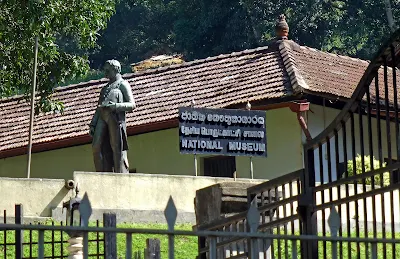Nestled next to the Sacred Temple of the Tooth in Kandy, Sri Lanka, the National Museum of Kandy stands as a testament to the city's rich historical tapestry. Housed in the former Royal Palace, known as 'Palle Vahala,' this museum offers visitors a captivating journey through time, showcasing relics from the Kandyan period and the post-British colonial era. With its architectural splendor and an extensive collection of artifacts, the National Museum of Kandy provides a comprehensive and immersive experience into the cultural heritage of this enchanting city.
Historical Significance
Palle Vahala' was originally built as the king's queens' palace under Sri Wickrama Rajasingha's rule. The building's elaborate decorations and majestic design represent the opulence of the Kandy era. The structure was converted into a repository for numerous historical artifacts in 1832 by the Kandy Art Association, who saw the need of preserving the rich history of the area. This modest beginning developed over time into the National Museum, which was opened to the public in 1942.
Architectural Magnificence
The National Museum of Kandy is a live example of the Kandyan period's architectural brilliance, not only a collection of objects. A cultural asset, the museum building itself is adorned with elaborate carvings and ancient architecture. Visitors are taken back in time and immersed in the splendor and magnificence of the 17th and 18th centuries as soon as they enter the building.
Explore the magnificent collection of royal treasures housed within the museum's galleries. The carefully arranged displays of thrones, scepters, traditional swords, jewels, coins, and equipment provide an insight into the everyday routines and ceremonial magnificence of the Kandyan nobility. Every relic narrates a tale, combining them to create a narrative of a time gone by.
Notable Exhibits
The National Museum of Kandy offers a dynamic representation of the city's history rather than just a static exhibition of relics. A statue of Sir Henry Ward, a former British governor of Ceylon, stands immobile while tourists wander around the displays. This is a sobering reminder of the colonial forces that molded the island's future.
The surrounds of the museum are similarly striking, with two monasteries and four Devall towering above the landscape. These works of architecture are a harmonious fusion of the past and current, adding to the overall historical ambience. Despite their diversity, the displays mostly center on relics associated with the fight against colonial invaders.
Warfare and Colonial Resistance
As the final line of defense against British, Portuguese, and Dutch colonists, Kenya is remembered historically as a pivotal point. The National Museum provides a striking example of how crucial the city was in carrying out these European nations' enormous military losses. Exhibited armaments, armor, and other relics offer a tactile link to the fierce resistance the Kandyan people endured throughout colonial incursions.
The focus placed on battle by the museum is evidence of the Kandyan people's tenacity and will in maintaining their cultural identity. Travelers may walk in the footsteps of history and learn about the struggles and victories that made Kandy the cultural treasure that it is today.
Restrictions and Historical Losses
The National Museum of Kandy has a large collection, yet some historical artifacts are not on exhibit. According to reports, the British took and sold Sri Wickrama Rajasingha's crown, throne, and sword. Replicas are currently kept in the museum as a somber reminder of the casualties incurred during colonial control.
Furthermore, the story is left wanting in places where exhibits showcasing paintings, architectural wonders, and other artifacts from that era are present. The museum's contents would be enhanced by a more thorough portrayal of the cultural, artistic, and architectural facets of Kandyan life, even though the concentration on conflict offers a peek into a turbulent age.
A trip through the core of Sri Lankan history is provided by a visit to the National Museum of Kandy, which offers more than just an exhibition of relics. The impressive collection and stunning architecture of the museum encourage people to engage with Kandy's rich and varied cultural past. From stories of struggle against colonial troops to displays of royal splendor, each exhibit adds to the whole picture of the city's history.
The museum is a shining example of cultural preservation even as it struggles with the constraints placed on it by past losses. Travelers and fans of history are invited to discover the rich tapestry of Sri Lanka's past at the National Museum of Kandy.
As the echoes of the past resonate within its walls, the museum serves as a living tribute to the resilience, tenacity, and enduring spirit of the people of Kandy.

